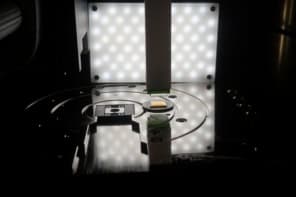
Since their invention in 2000, exotic materials called metamaterials have revealed many uses such as perfect lenses or invisibility cloaks. But now computer simulations performed by physicists in the UK suggest another application — slowing down a “rainbow” of light to a standstill. Their idea could be the first route to storing broadband, optical communications at room temperature.
“Slow light” does not refer to the actual speed of photons, but to the speed of a wave packet, which is the transmission of energy in a light wave. It isn’t a new trick — structures containing alternating regions of high and low refractive index called photonic crystals can reduce the group velocity to a crawl, and a technique called electromagnetically-induced transparency (EIT) can stop light altogether in gases of ultracold atoms.
Potentially, slow light could be used to replace electrical devices that store communications signals, thus avoiding time-consuming conversions from one medium to another. But currently EIT cannot be performed in a room-temperature gas, and both EIT and photonic crystals are unable to slow light at anything other than a narrow range of frequencies. This limits their usefulness in communications, which are typically broadband.
Bright idea
Stopping light inside a solid-state device was thought to be infeasible
Ortwin Hess and colleagues at the University of Surrey and the University of Salford in the UK say the answer to storing communications signals at room temperature and at a range of frequencies could lie in metamaterials — artificial materials displaying unusual electromagnetic properties such as negative refraction. They have performed a computer analysis of light rays passing through a metamaterial comprising a tapered, negatively-refracting waveguide encompassed by positively-refracting material (Nature 450 397). “Until now, stopping light inside a solid-state device was thought to be infeasible,” said Hess.
Whenever light travels through a waveguide the rays bounce between the limits of the waveguide in a zigzag fashion. In a waveguide made of a positively refracting material — such as a fibre optic — surrounded by a positively-refracting medium, there is always a small positive phase shift at each reflection, which makes the ray “jump” a little farther ahead. If the waveguide is negatively refracting, the phase shift is negative, and the jump is backwards. The key finding of the UK group’s ray analysis is that if such a waveguide gets narrower, the light covers less and less distance between reflections, and eventually the backwards jumps will dominate — so the group velocity is stopped in its tracks.
The stop point would not be the same for all colours of light, however. Because the electromagnetic properties of a metamaterial depend on the wavelength of the light, the blue component would be stopped first and red last, with a “trapped rainbow” in between. This, says Hess, means that an optical storage device based on the idea could be used to separately process different components of light. “Naturally, our immediate plans include the experimental implementation of the ‘trapped rainbow’ method,” he added.



